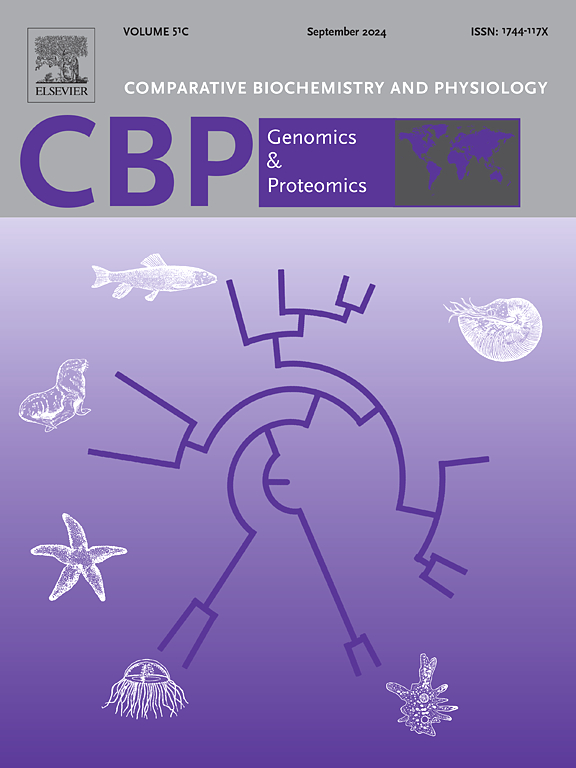溶藻弧菌诱导胞外陷阱形成的信号通路。
IF 2.2
2区 生物学
Q4 BIOCHEMISTRY & MOLECULAR BIOLOGY
Comparative Biochemistry and Physiology D-Genomics & Proteomics
Pub Date : 2025-05-23
DOI:10.1016/j.cbd.2025.101547
引用次数: 0
摘要
细胞外陷阱(Extracellular traps, ETs)由dna -蛋白网络组成,在许多物种中广泛存在并发挥先天免疫防御作用。值得注意的是,中间圆梭菌完全依靠先天免疫来抵抗疾病。本研究探讨了在溶藻弧菌的刺激下,中间葡萄球菌体腔细胞中ETs的形成及其初步机制。这些结果表明,随着溶藻弧菌浓度的增加,et的形成更加显著。流式细胞术分析显示,ETs的形成过程伴随着线粒体指标的变化,提示线粒体可能参与了溶藻毒素诱导的ETs的形成过程。转录组分析表明,中间棘豆体腔细胞产生的ETs与糖酵解和ATP合成有关。在该转录组中共筛选出2631个差异表达基因(deg)。然后,我们从16个信号通路中筛选了34个免疫相关的deg来构建PPI网络,并定义了ATP6、ND2、G3PDH、MAPK7等相关基因对应的枢纽蛋白。这些基因与线粒体功能、糖酵解途径和免疫途径有关。此外,ETs的形成导致多种免疫调节因子的改变,如TNF、NF-κB、MAPK、PI3K-AKT和mTOR,暗示其在细胞免疫调节中的作用。实时荧光定量PCR实验显示,在et形成腔胚细胞中鉴定和验证的一些deg的表达变化与转录组分析结果相匹配。本研究为中棘虾养殖提供了新的思路,阐明了海洋生物免疫机制,促进了对无脊椎动物先天免疫的认识。本文章由计算机程序翻译,如有差异,请以英文原文为准。

Signaling pathways underlying extracellular trap formation induced by Vibrio alginolyticus in Strongylocentrotus intermedius
Extracellular traps (ETs), comprising a DNA-protein network, are widespread and function as an innate immune defense in many species. Notably, Strongylocentrotus intermedius solely depend on innate immunity for disease resistance. This study investigated the formation and preliminary mechanism of ETs in the coelomocytes of the S. intermedius under the stimulation of bacterium Vibrio alginolyticus. These results revealed that as the concentration of V. alginolyticus increased, the formation of ETs became more significant. Flow cytometry analysis showed that the formation process of ETs was accompanied by changes in mitochondrial indicators, suggesting that mitochondria may be involved in the formation process of V. alginolyticus-induced ETs. Transcriptome analysis indicated that the ETs production by coelomocytes of the S. intermedius was related to glycolysis and ATP synthesis. A total of 2631 differentially expressed genes (DEGs) were screened in this transcriptome. We then screened 34 immune-related DEGs from 16 signaling pathways to construct the PPI network, and defined hub proteins corresponding to genes such as ATP6, ND2, G3PDH, MAPK7 and other related genes. These genes are related to mitochondrial function, glycolytic pathways, and immune pathways. Additionally, the formation of ETs led to alterations in multiple immune regulators, such as TNF, NF-κB, MAPK, PI3K-AKT, and mTOR, implying its role in cellular immunomodulation. Quantitative real-time PCR experiment revealed that the expression changes of some DEGs identified and validated in ET-formation coelomocytes matched transcriptome analysis results. This study provided insights into S. intermedius aquaculture, elucidated marine organism immune mechanisms, and advanced invertebrate innate immunity understanding.
求助全文
通过发布文献求助,成功后即可免费获取论文全文。
去求助
来源期刊
CiteScore
5.10
自引率
3.30%
发文量
69
审稿时长
33 days
期刊介绍:
Comparative Biochemistry & Physiology (CBP) publishes papers in comparative, environmental and evolutionary physiology.
Part D: Genomics and Proteomics (CBPD), focuses on “omics” approaches to physiology, including comparative and functional genomics, metagenomics, transcriptomics, proteomics, metabolomics, and lipidomics. Most studies employ “omics” and/or system biology to test specific hypotheses about molecular and biochemical mechanisms underlying physiological responses to the environment. We encourage papers that address fundamental questions in comparative physiology and biochemistry rather than studies with a focus that is purely technical, methodological or descriptive in nature.

 求助内容:
求助内容: 应助结果提醒方式:
应助结果提醒方式:


